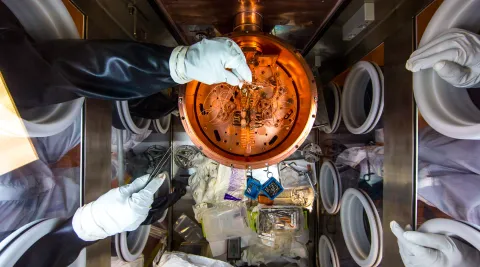MAJORANA Collaboration to discuss final results, announce new measurements of tantalum-180m experiment
Press release media

Researchers work on the Majorana Demonstrator’s inner detectors in a glovebox in a cleanroom on SURF’s 4850 Level. Photo by Matthew Kapust
LEAD, SD— The Majorana Collaboration and the Sanford Underground Research Facility (SURF) invite members of the media to a discussion of the experiment’s final results as published on Feb. 10, 2023, in Physical Review Letters. The collaboration will also announce new measurements from a search for the decay of nature’s rarest isotope: tantalum-180m.
The Majorana Demonstrator was managed by Oak Ridge National Laboratory (ORNL) for the U.S. Department of Energy Office of Nuclear Physics with support from the National Science Foundation. The experiment ran from 2015 through 2021 on the 4850 Level of SURF.
The collaboration’s final results prove that the techniques used by the collaboration could be deployed on a much larger scale to search for the rare, never-before-seen decay known as “neutrinoless double-beta decay.” This theoretical decay could help explain the existence of matter in our Universe.
“The purpose of the Majorana Demonstrator was to prove that our detector design and technology was advanced enough to justify the creation of a ton-scale experiment,” said Vincente Guiseppe, co-spokesperson of the Majorana Collaboration and a research staff member at ORNL. “This paper—the culmination of six years of data and the final word on the Majorana Demonstrator—proves that we have achieved what we set out to do.”
The collaboration’s triumphs include a world-leading energy resolution and a confirmation that the half-life of neutrinoless double-beta decay in germanium-76 is greater than 8.3×1025 years. The collaboration conducted searches for exotic dark matter and for possible interactions beyond the Standard Model of particle physics.
“When we started this project, there were many risks and no guarantee that we could achieve our goals, as we were pushing into unexplored territory,” said John Wilkerson, principal investigator of the experiment and professor of physics at the University of North Carolina. “Today, we’re one step closer to understanding the imbalance in the Universe—and why we exist at all.”
The Majorana Demonstrator’s science run ended in 2021, and the detector was repurposed to search for the decay of nature’s rarest isotope: tantalum-180m. The Majorana Collaboration will provide a status update and announce new measurements from this search at the webinar.
“Tantalum is the only unobserved metastable state decay,” said Samuel Meijer, staff scientist at Los Alamos and co-principal investigator of the tantalum search. “Every nuclear physicist has heard of this problem; it’s an open, standing question.”
How to attend:
The webinar presentation will take place on Thursday, Feb. 23, from 1:30 to 2:45 p.m. MT. The presentation is expected to run for 50 minutes, with an additional 20 minutes for questions and discussion with the virtual audience. Advance registration is encouraged. To register for the Zoom webinar, visit our event webpage.
Sanford Underground Research Facility is operated by the South Dakota Science and Technology Authority (SDSTA) with funding from the Department of Energy’s Office of Science. Our mission is to advance world class science and inspire learning across generations. Visit SURF at www.sanfordlab.org.